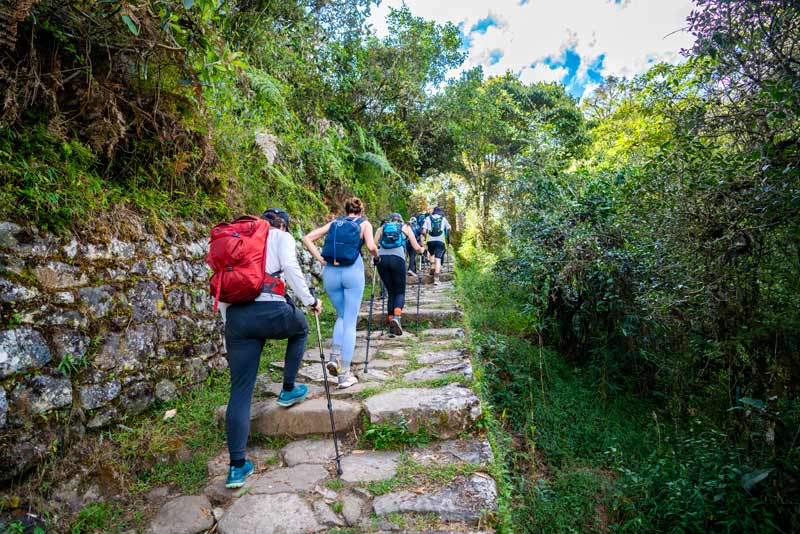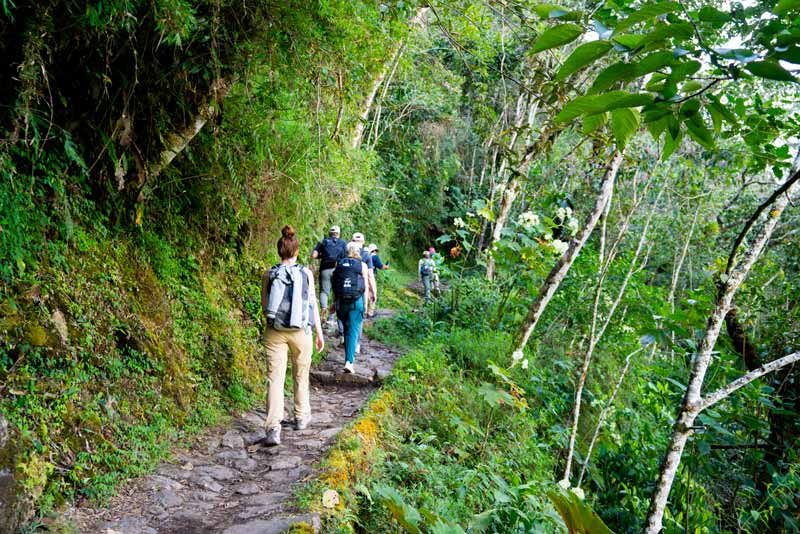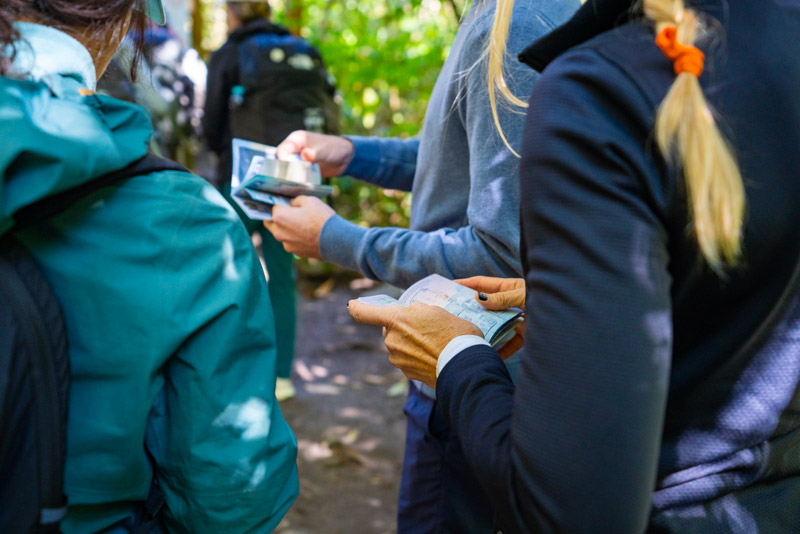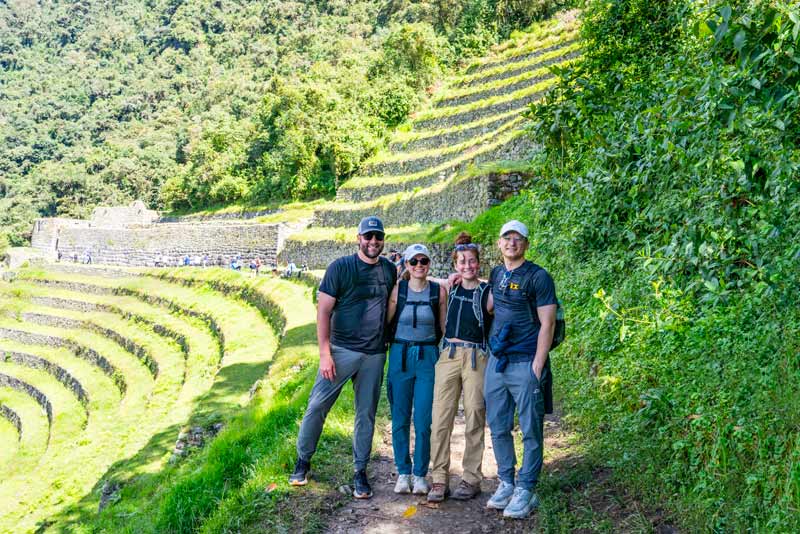First time on the Inca Trail? This guide is for you
Thinking about hiking the Inca Trail? Before embarking on this journey, there are key details that can make the difference between a good experience and a route filled with setbacks. This article brings together essential tips, common mistakes, and practical recommendations that many travelers wish they’d known before starting.
- General information
- Preparations before the trip
- Equipment and recommendations
- Day by day of the tour
- Frequently Asked Questions
General information
What is the Inca Trail?
The Inca Trail is an ancient route built by the Incas and part of the road system known as Qhapaq Ñan. It is located in the Cusco region of southern Peru and connects several archaeological sites leading to the citadel of Machu Picchu. This trail traverses diverse Andean and jungle landscapes, crossing mountains, cloud forests, and preserved archaeological sites.
History and relevance of the path
The Inca Trail is part of an extensive network of trails called Qhapaq Ñan, which connected the entire Inca Empire, from Colombia to Argentina. However, the most famous section is the one that connects the Sacred Valley with Machu Picchu, a 43-km route built in the 15th century during the reign of Inca Pachacútec. This route was not only an access route, but also a ceremonial route to a sacred site.
It was built with advanced techniques for its time, such as stone staircases, water channels, and tunnels adapted to the difficult Andean terrain. It served religious, political, and military purposes, and was used by messengers, priests, and authorities. Along the route were tambos (rest centers) and small settlements that facilitated travel within the empire.
After the arrival of the Spanish, the trail was abandoned and overgrown. It remained hidden until its rediscovery in the 20th century, just like Machu Picchu. Today, this section is one of the most famous hiking trails in the world and a testament to the impressive architectural and cultural legacy of the Incas.
Types of routes (classic, short, combined)
- Classic: This is the route most preferred by most travelers. It starts in the town of Piskacucho, from where you can hike for four days to reach the citadel of Machu Picchu.
- Short : For travelers short on time, this route is ideal. It begins in Chachabamba, near the hydroelectric plant, and can be completed in a single day. The next day, you’ll visit the citadel of Machu Picchu.
- Combined: Some travel agencies offer trekking routes that combine the classic route with the shorter route, making the journey much longer.
The best season to hike the Inca Trail
The best time to hike the Inca Trail is during the dry season, which runs from April to September . During this period, the weather conditions are fairly stable, with no rain, making it easier to navigate the trail and allowing you to enjoy unobstructed views of the Machu Picchu citadel.
Have you already booked for the rainy season? In that case, you’ll need to pack waterproof clothing to allow you to move around in the rain, as well as choose the right time to enter Machu Picchu to avoid the fog.
Preparations before the trip
What to carry in your backpack?
- Identity documents and/or passport.
- Extra money (soles).
- Bottle of water.
- Personal medication.
- Sunscreen (SPF 50+).
- Hat.
- Personal care items.
- Waterproof polar fleece jacket.
- Trekking shoes.
- Trekking pants (detachable).
- Rain poncho.
- Trekking poles (rent from us).
- Sleeping bag (rent from us).
- Duffle bag (we provide it).
- Medium trekking backpack.
- Camera.
- Charger and portable battery.
- Healthy snacks.
- Flashlight.
How to prepare physically
This is one of the first steps you shouldn’t overlook on your trip. Why? Keep in mind that the route is moderately to challenging, which inevitably involves physical demands. Therefore, it’s very important to be in decent physical condition to avoid overexertion.
To prepare physically, you don’t need to follow the routines of athletes or professionals. Simply doing exercises like walking, running, or swimming will be enough to strengthen your legs and breathing capacity. Make sure you prepare at least two weeks before your trip so you’ll arrive in Cusco ready to begin the Inca Trail.
Necessary documents
- DNI: Citizens of the Peruvian state.
- Identity document: Argentina, Brazil, Paraguay, Ecuador, Uruguay, Colombia, Bolivia, Chile.
- Visa: Cuba, El Salvador, Haiti, Nicaragua.
- Passport: Countries not mentioned above.
Note:
Don’t forget to bring your necessary documents for the Inca Trail. If you don’t have them with you, you won’t be allowed entry, even if you have everything ready and are with your travel agency. This also applies to entering Machu Picchu.
Recommendations for altitude sickness
To begin, you should know that altitude sickness is a condition that affects many travelers from places below 1,500 meters above sea level. This condition causes symptoms such as nausea, headache, and shortness of breath. These symptoms typically disappear within a few hours or even a full day.
Upon arriving in Cusco, it’s very important to set aside at least one day to acclimatize before starting the Inca Trail. This time will allow your body to adjust to the altitude and for symptoms to diminish, or ideally, prevent them from occurring .
Note:
Traveler, if you experience symptoms during the Inca Trail, although it’s unlikely, it’s important to inform your guide about your condition. This way, the travel agency can provide support with generic medications and natural remedies.
Equipment and recommendations
The best type of backpack
This item will be one of your most valuable companions throughout your hike. It’s important to choose a backpack that looks after your well-being and helps you carry your belongings comfortably. Here are some details to help you choose the ideal backpack:
- Capacity from 30 to 50 liters.
- Adjustable and padded straps.
- Good lumbar support.
- Waterproof cover or water-resistant material.
- Accessible pockets for water, snacks and personal items.
Trekking poles: yes or no?
If you’re thinking of bringing trekking poles, yes you can! But they must have rubber tips. Why? Because this trail is very well maintained, and poles with steel or metal tips could damage the path, especially the cobblestone steps you’ll encounter along the way.
Take note! If you don’t have your own walking sticks, you can buy them in Cusco or rent them from the travel agency you booked your tour with. These are very important items that will support you during your daily hikes, both uphill and downhill.
Recommended clothing by season.
I see you want to be more than ready for this hike! Let’s start with the basics: no matter what season you decide to hike, it’s important to pack lightweight clothing that allows you to move freely, without being restricted by seams. That’s why many travelers opt for trekking pants, as they offer plenty of flexibility. It’s also important to bring long-sleeved polo shirts, a hat, and a fleece-lined windbreaker to keep you warm.
On the other hand, avoid formal or urban clothing. Why? Because they’re not designed for rural terrain. This will make your steps short and uncomfortable on several sections of the trail. Also, remember that you’ll be deep in the Cusco jungle, so these clothes could easily get damaged. You don’t want to end up with ripped pants, do you?
Ideal footwear for the Inca Trail
Keep in mind that you’ll be hiking for many hours, so it’s very important to have appropriate footwear. It should have the necessary technology to provide good traction with every step and protect your feet throughout the entire hike. For this reason, trekking shoes or sneakers are the most recommended for hiking the Inca Trail.
If you’re wondering whether you can wear formal or urban shoes, the answer is no. Avoid these types of shoes at all costs, as they offer no traction or protection. You could slip, suffer injuries from constant friction, or even damage your shoes on the first day. You don’t want to end up with broken shoes in the middle of the trail, do you?
Day by day of the tour
Food during the route
Worried? Don’t worry. Keep in mind that this route can only be done with a travel agency, and food is included in their services. They typically offer easy-to-cook meals made with local produce. Plus, most agencies also include snacks to munch on along the way and water to keep you hydrated.
If you have any dietary preferences, don’t worry. Most agencies offer flexibility to accommodate your needs. However, it’s very important to inform them of your situation in advance. Why? Because if you don’t, you’ll have to eat what’s already on the agency’s menu. Remember that there are no food outlets along the route, as all supplies are brought in from the city of Cusco. Don’t forget this!
Accommodations and camps
Take note! No matter which travel agency you choose to hike the Inca Trail with, you can be sure that your nights will be spent in tents, under the stars. Why? There are no hotels along the Inca Trail route , as their construction is prohibited as a protective measure to preserve its historical value and the international recognition it has earned.
On the other hand, if you see a travel agency offering a hotel night as part of the package, keep in mind that this service is usually provided on the last night and in the town of Aguas Calientes. This option is usually included in the 5-day or 2-day Inca Trail.
Note:
It’s very important to carefully review the inclusions of the tour packages offered by agencies. Make sure camping equipment is included in the service. You don’t want to have any problems during your trip, do you?
Attractions visited on the Inca Trail
| Tourist attraction | Description |
|---|---|
| Patallacta (Llactapata) | A large complex of platforms and enclosures located near the start of the classic Inca Trail. It may have served as an agricultural center and strategic control point. |
| Runkurakay | A circular structure built on a hillside. It is thought to have been a tambo or resting place for Inca travelers and messengers. |
| Sayacmarca | A difficult-to-access site with enclosures, stairways, and passageways. Its location suggests administrative, defensive, and ceremonial functions. |
| Phuyupatamarca | A mountaintop site with fountains, platforms, and viewing platforms. Associated with rituals and astronomical observation. |
| Intipata | A set of agricultural terraces overlooking the Urubamba River Valley. This is likely a farming area to supply nearby areas. |
| Chachabamba (Only on the 2-day Inca Trail) | A complex of stone enclosures and water channels. It is believed to have been a ceremonial center linked to the worship of water and a checkpoint to Machu Picchu. |
| Wiñay Wayna | An important complex with terraces, enclosures, and fountains. It served agricultural, residential, and ceremonial purposes. |
| Intipunku | (Sun Gate) Ceremonial entrance to Machu Picchu with a panoramic view. It allowed access to the citadel to be controlled. |
| Machu Picchu | An Inca city built in the 15th century. It includes agricultural, urban, and religious sectors. It is notable for its planning and architecture. |
Frequently Asked Questions
1) How many days does the Inca Trail last?
The Inca Trail has three routes: the 2-day, 4-day, and 5-day routes. You’ve probably heard that it takes longer, which is relatively true, as some travel agencies offer combined packages that combine the Inca Trail with other trekking routes, making your adventure even longer.
2) Is it mandatory to hire an authorized agency?
Yes, this is one of the mandatory requirements for entering the Inca Trail. If you don’t hire an authorized travel agency, you won’t be allowed entry, even if you already have your tickets.
3) How much does it cost to do the Inca Trail?
If you choose the classic route, you’ll find prices ranging from $700 to $1,500. Everything will depend on the type of service you choose and the level of comfort you require during your trip.
4) How far in advance should I book?
You must make your reservation at least six months in advance. You really need to be very cautious here. Why? The number of tickets is much smaller than for Machu Picchu, and demand is very high, so they tend to sell out quickly.
5) Can I do the Inca Trail on my own?
No, you can’t do it on your own. Why? This route is regulated by the Ministry of Culture, and in order to protect it, it requires all tourists to hire the services of an agency authorized by SERNANP.
Note: Very few agencies are authorized by SERNANP; only they are allowed to operate tourism services on the Inca Trail.
6) What is the difficulty level of the route?
The Inca Trail ranges in difficulty from moderate to challenging, so prior physical preparation is very important. It’s also essential to acclimatize to Cusco before beginning the hike, so you can better face the challenges of the journey.
7) What happens if I get sick during the trek?
If you become ill, your first step is to inform your tour guide about your condition so they can provide you with help with the support of the travel agency staff. They will provide you with some generic medications or natural remedies. On the other hand, during the hike, it’s important to go at your own pace; no one will rush you.
8) Can the Inca Trail be done all year round?
Traveler, please note that this trekking route is not available during the month of February. Why? During that month, maintenance work is carried out on the trail so it can continue to be used safely throughout the rest of the year.
9) What happens if there are no more places available for the classic Inca Trail?
If you don’t find availability, your only option is to reschedule your trip to a date with available space. Additional tickets beyond the established limit are not released. You could also opt for the short Inca Trail, subject to availability.
10) Does the Inca Trail go directly to Machu Picchu?
Of course! Keep in mind that this is the only trekking route that goes directly to the citadel, which makes it very popular. Don’t forget! If you want to take this route, it’s very important to book in advance.
Advice from people who have been there
 By: Kaela M.
By: Kaela M.“Inca Trail“
“An unforgettable experience. I loved every part of the tour, especially the ancient sites we saw along the way, which were full of history. The guide explained everything clearly and in great detail, which made you even more interested.“
By Ticket Machu Picchu – Last updated, May 31, 2025



